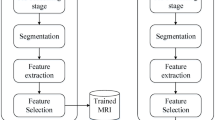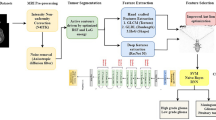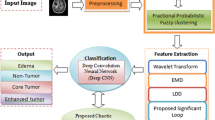Abstract
Classification of brain tumor is highly significant in the medical field in real-world to improve the progress of treatments. The seriousness behind the tumors are normally graded based on the size into grade I, grade II, grade III and grade IV. This is where the process of multi-grade brain tumor classification gains attention. Thus, the article focusses on classifying the brain MRI images into four different grades by proposing a novel and a very efficient classification strategy with high accuracy. The acquired images are pre-processed with the help of an Extended Adaptive Wiener Filter (EAWF) and then segmented using the piecewise Fuzzy C-means Clustering (piFCM) technique. Then the most ideal features such as the texture, intensity and shape features that can best explain the growth of tumors are extracted using the Local Binary Pattern (LBP) and the Hybrid Local Directional Pattern with Gabor Filter (HLDP-GF) techniques. After extracting the ideal features, the Manta Ray Foraging Optimization (MRFO) method has been introduced to optimally select the most relevant features. Finally, a Hybrid Deep Neural Network with Adaptive Rain Optimizer Algorithm (HDNN-AROA) is proposed to classify the grades of brain tumors with high accuracy and efficiency. The proposed technique has been compared with the existing state-of-the-art techniques relevant to brain tumor classification in terms of accuracy, precision, recall and dice similarity coefficient to prove the overall efficiency of the system.












Similar content being viewed by others
References
Aboelenein NM, Songhao P, Koubaa A, Noor A, Afifi A (2020) HTTU-net: hybrid two track U-net for automatic brain tumor segmentation. IEEE Access 8:101406–101415
Ali MB, Gu IY, Berger MS, Pallud J, Southwell D, Widhalm G, Roux A, Vecchio TG, Jakola AS (2020) Domain mapping and deep learning from multiple MRI clinical datasets for prediction of molecular subtypes in low grade gliomas. Brain Sci 10(7):463
Ayadi W, Elhamzi W, Charfi I, Atri M (2021) Deep CNN for brain tumor classification. Neural Process Lett 53:1–30
Baliarsingh SK, Vipsita S (2020) Chaotic emperor penguin optimised extreme learning machine for microarray cancer classification. IET Syst Biol 14(2):85–95
Baliarsingh SK, Vipsita S, Gandomi AH, Panda A, Bakshi S, Ramasubbareddy S (2020) Analysis of high-dimensional genomic data using MapReduce based probabilistic neural network. Comput Methods Prog Biomed 195:105625
Baliarsingh SK, Muhammad K, Bakshi S (2021) SARA: a memetic algorithm for high-dimensional biomedical data. Appl Soft Comput 101:107009
CabezasM, Valverde S, González-Villà S, Clérigues A, SalemM, Kushibar K, Bernal J, Oliver A, Lladó X (2018) Survival prediction using ensemble tumor segmentation and transfer learning. arXiv preprint arXiv:1810.04274
Caver E, Chang L, Zong W, Dai Z, Wen N (2018) Automatic brain tumor segmentation using a U-net neural network. In: Pre-conference proceedings of the 7th MICCAI BraTS challenge, 63-73
Deepak S, Ameer PM (2019) Brain tumor classification using deep CNN features via transfer learning. Comput Biol Med 111:103345
Dequidt P, Bourdon P, Ahmed OB, Tremblais B, Guillevin C, Naudin M, Fernandez-Maloigne C, Guillevin R (2019) Recent advances in glioma grade classification using machine and deep learning on MR data. In: 2019 fifth international conference on advances in biomedical engineering (ICABME), IEEE, 1-4
Díaz-Pernas FJ, Martínez-Zarzuela M, Antón-Rodríguez M, González-Ortega D (2021) A deep learning approach for brain tumor classification and segmentation using a multiscale convolutional neural network. Healthcare 9(2):153
Hsieh KL-C, Lo C-M, Hsiao C-J(2017)Computer-aided grading of gliomas based on local and global MRI features. Comput Methods Prog Biomed 139:31–38
Hu A, Razmjooy N (2021) Brain tumor diagnosis based on metaheuristics and deep learning. Int J Imaging Syst Technol 31(2):657–669
Jefferson B, Shanmugasundaram RS (n.d.) Brain Tumor Classification in 3d-Mri Using Features From Radiomics and 3d-Cnn Combined With Knn Classifier International Journal of Electrical Engineering and Technology (IJEET) 12
Joardar BK, Jayakodi NK, Doppa JR, Li H, Pande PP, Chakrabarty K (2020) GRAMARCH: a gpu-reram based heterogeneous architecture for neural image segmentation. In: 2020 Design, Automation & Test in Europe Conference & Exhibition (DATE), IEEE, 228-233
Jones TL, Byrnes TJ, Yang G, Howe FA, Bell BA, Barrick TR (2015) Brain tumor classification using the diffusion tensor image segmentation (D-SEG) technique. Neuro-oncology 17(3):466–476
Kumar RL, Kakarla J, Isunuri BV, Singh M (2021)Multi-class brain tumor classification using residual network and global average pooling. Multimed Tools Appl 80:–34
Kurc T, Bakas S, Ren X, Bagari A, Momeni A, Huang Y, Zhang L, Kumar A, Thibault M, Qi Q, Wang Q (2020) Segmentation and classification in digital pathology for glioma research: challenges and deep learning approaches. Front Neurosci 14:27
Maekawa T, Hori M, Murata K, Feiweier T, Kamiya K, Andica C, Hagiwara A, Fujita S, Koshino S, Akashi T, Kamagata K (2020) Differentiation of high-grade and low-grade intra-axial brain tumors by time-dependent diffusion MRI. Magn Reson Imaging 72:34–41
Meier R, Bauer S, Slotboom J, Wiest R, Reyes M (2013) A hybrid model for multimodal brain tumor segmentation. Multimodal Brain Tumor Segmentation 31:31–37
Menze B, Isensee F, Wiest R, Wiestler B, Maier-Hein K, Reyes M, Bakas S (2020) Analyzing magnetic resonance imaging data from glioma patients using deep learning. Comput Med Imaging Graph 88:101828
Minaee S, Boykov Y, Porikli F, Plaza A, Kehtarnavaz N, Terzopoulos D (2020) Image segmentation using deep learning: a survey. arXiv preprint arXiv:2001.05566. Transactions on Pattern Analysis and Machine Intelligence
Moazzeni AR, Khamehchi E (2020) Rain optimization algorithm (ROA): a new metaheuristic method for drilling optimization solutions. J Pet Sci Eng 195:107512
Mohanaiah P, Sathyanarayana P, GuruKumar L (2013) Image texture feature extraction using GLCM approach. Int J Sci Res Publ 3(5):1–5
Mzoughi H, Njeh I, Wali A, Slima MB, BenHamida A, Mhiri C, Mahfoudhe KB (2020) Deep multi-scale 3D convolutional neural network (CNN) for MRI gliomas brain tumor classification. J Digit Imaging 33:903–915
Narmatha C, Eljack SM, Tuka AARM, Manimurugan S, Mustafa M (2020) A hybrid fuzzy brain-storm optimization algorithm for the classification of brain tumor MRI images. Journal of Ambient Intelligence and Humanized Computing:1–9
Pang S, Du A, Orgun MA, Yu Z, Wang Y, Wang Y, Liu G (2020) CTumorGAN: a unified framework for automatic computed tomography tumor segmentation. Eur J Nucl Med Mol Imaging 47(10):2248–2268
Prabhu LA, Jayachandran A (2018) Mixture model segmentation system for parasagittal meningioma brain tumor classification based on hybrid feature vector. J Med Syst 42(12):1–6
Ryall S, Tabori U, Hawkins C (2020) Pediatric low-grade glioma in the era of molecular diagnostics. Acta Neuropathol Commun 8(1):1–22
Salehi H, Vahidi J, Abdeljawad T, Khan A, Rad SYB (2020) A SAR image Despeckling method based on an extended adaptive wiener filter and extended guided filter. Remote Sens 12(15):2371
Sasank VV, Venkateswarlu S (2021) Brain tumor classification using modified kernel based softplus extreme learning machine. Multimedia Tools Appl 80(9):13513–13534
Shaukat F, Raja G, Ashraf R, Khalid S, Ahmad M, Ali A (2019) Artificial neural network based classification of lung nodules in CT images using intensity, shape and texture features. J Ambient Intell Humaniz Comput 10(10):4135–4149
Singh R, Goel A, Raghuvanshi DK (2020) Computer-aided diagnostic network for brain tumor classification employing modulated Gabor filter banks. Vis Comput 37(8):2157–2171
Soltaninejad M, Yang G, Lambrou T, Allinson N, Jones TL, Barrick TR, Howe FA, Ye X (2017) Automated brain tumour detection and segmentation using superpixel-based extremely randomized trees in FLAIR MRI. Int J Comput Assist Radiol Surg 12(2):183–203
Udendhran R, Balamurugan M, Suresh A, Varatharajan R (2020) Enhancing image processing architecture using deep learning for embedded vision systems. Microprocess Microsyst 76:103094
Zacharaki EI, Wang S, Chawla S, Yoo DS, Wolf R, Melhem ER, Davatzikos C (2009) Classification of brain tumor type and grade using MRI texture and shape in a machine learning scheme. Magn Reson Med 62(6):1609–1618
Zhang HM, Dong B (2020) A review on deep learning in medical image reconstruction. J Oper Res Soc China:1–30
Zhao W, Zhang Z, Wang L (2020) Manta ray foraging optimization: an effective bio-inspired optimizer for engineering applications. Eng Appl Artif Intell 87:103300
Zhou Z, He Z, Jia Y (2020) AFPNet: a 3D fully convolutional neural network with atrous-convolution feature pyramid for brain tumor segmentation via MRI images. Neurocomputing 402:235–244
Author information
Authors and Affiliations
Corresponding author
Additional information
Publisher’s note
Springer Nature remains neutral with regard to jurisdictional claims in published maps and institutional affiliations.
Rights and permissions
About this article
Cite this article
Sasank, V.V.S., Venkateswarlu, S. Hybrid deep neural network with adaptive rain optimizer algorithm for multi-grade brain tumor classification of MRI images. Multimed Tools Appl 81, 8021–8057 (2022). https://doi.org/10.1007/s11042-022-12106-9
Received:
Revised:
Accepted:
Published:
Issue Date:
DOI: https://doi.org/10.1007/s11042-022-12106-9




